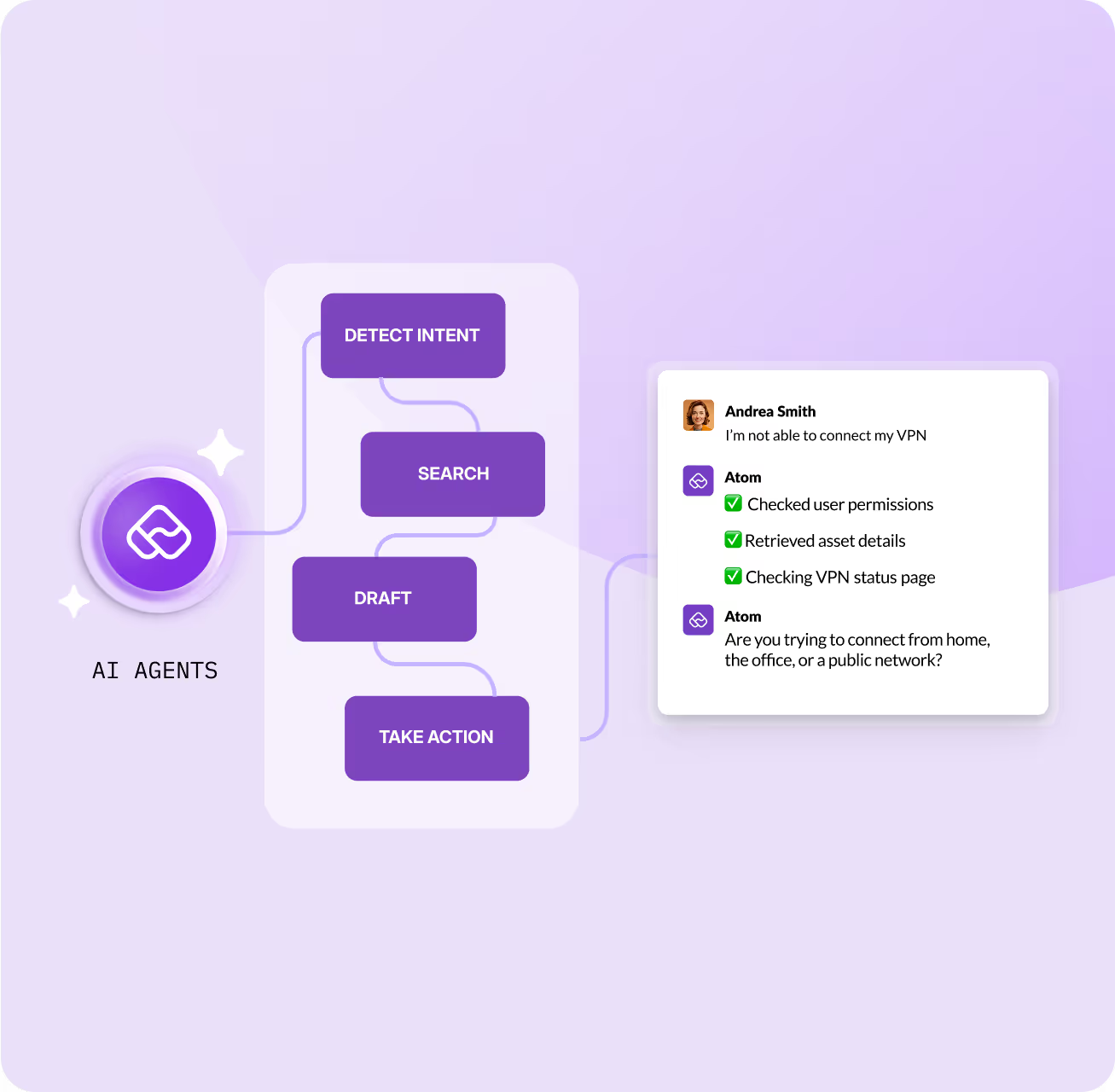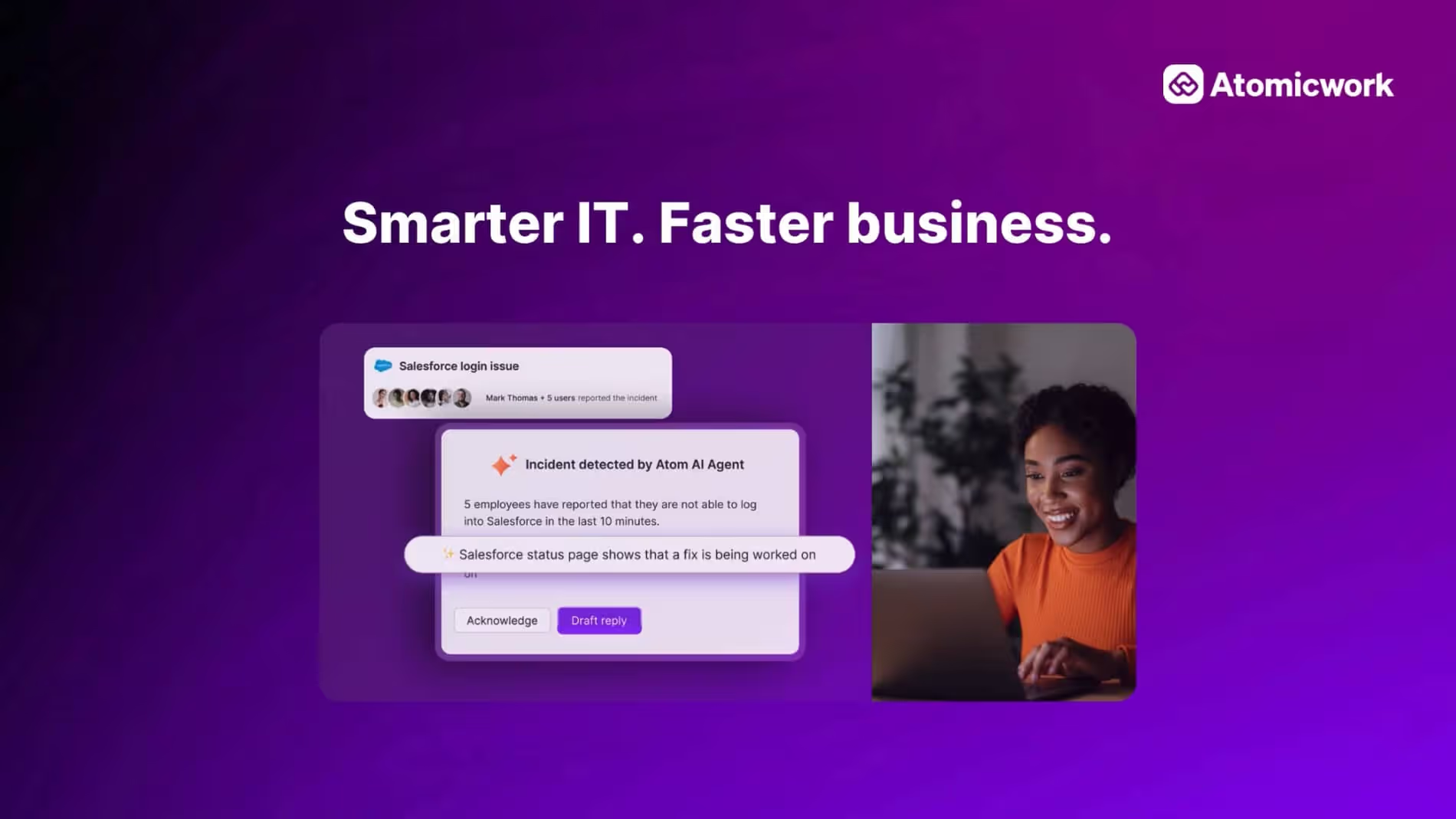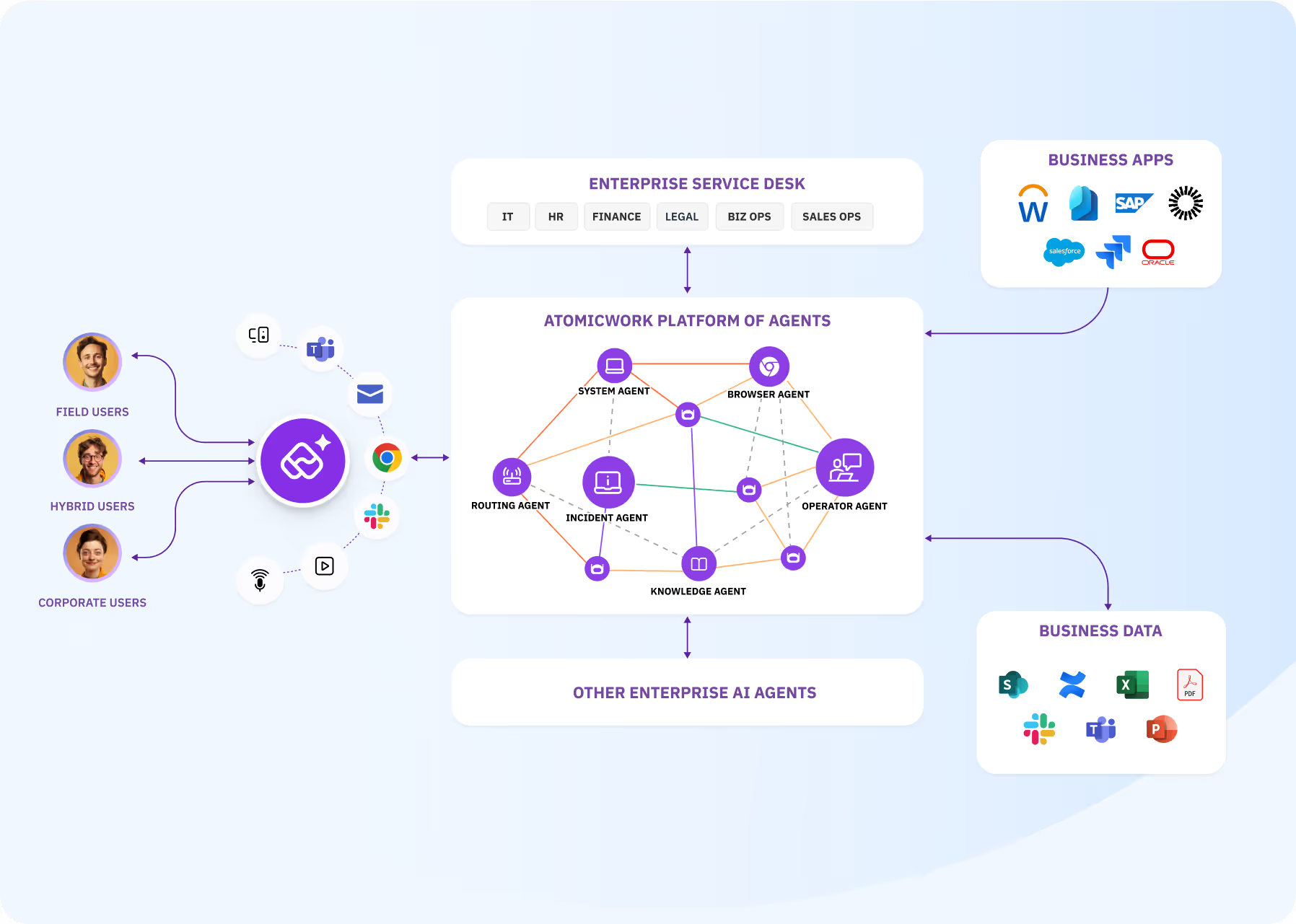


.avif)
Agentic Service Management (ASM) is a modern approach to IT and enterprise service management where AI agents reason, plan, and act alongside humans to actively troubleshoot, orchestrate IT workflows, and resolve issues proactively.
Unlike traditional service management that is more reactive and ticket-centric, agentic service management brings together agentic automation, organizational context, and continuous learning to make service delivery adaptive and autonomous.
Agentic service management turns service operations into a living and intelligent system that anticipates end-user needs, minimizes disruptions, and empowers organizations to offer always-on enterprise support.


Agentic AI leverages user, device, apps, workflow context to build a living knowledge graph that powers AI agents to offer proactive support in the flow of work.

Agentic service management thrives in a crew of AI agents, each with specific goals, orchestrated to work across IT, HR, or collaboration tools for intelligent operations.

AI agents shine at taking actions on behalf of IT teams with the information and systems they have access to that truly offloads work for the IT org.
Traditional ITSM has been characterized by manual, process-heavy workflows and a largely reactive approach. Agentic service management, by contrast, is AI-driven, proactive, and autonomous to execute service tasks independently.
IT Teams with Bolt-on AI | IT Teams with Built-in AI |
Ticket-centric Every interaction turns into a 'ticket' for IT teams to track, troubleshoot, and resolve issues with several clicks and follow ups. | Service-first The focus is on autonomously resolving employee issues across any channel, before they even become tickets. |
Configuration-based Admins need to build rigid configuration items and maintain the repository manually. | Context-rich Context on user, systems, knowledge and conversations is updated automatically that reduces maintenance overhead. |
Rule-based workflows Predefined, deterministic workflows that are complex to configure and often fail in dynamic scenarios. | Goal-based work agents Autonomous AI agents can reason, adapt and act dynamically in different scenarios. |
Analog AI These systems are chat or ticket based that require users to describe issues clearly, causing delays. | Digital AI ASM can orchestrate between Chat, Voice, and Vision AI for users to speak or screenshare for faster resolutions. |
Agentic service management simplifies several repetitive, time-consuming processes with AI agents handling detailed root cause analysis, context-aware employee support, and agentic access provisioning.
Take the example of provisioning access for a Salesforce agent. AI agents can understand the request an employee raises in natural language on Slack or MS Teams, check with the Salesforce agent to see the level of existing access, orchestrate with the Okta agent to check entitlements and policies, before granting access. Thus, provisioning happens as one seamless, autonomous flow without frustrating end users.



Our agentic service management platform represents a paradigm shift with AI agents, with minimum training or supervision, taking over not just routine tasks but also complex business workflows with built-in enterprise knowledge graph and employee context.

Agentic service management requires a network of AI agents working together to create one single intelligent system. Each agent needs to be specialized, coordinated, and adapted to that workflow to manage complex use cases. That’s why we built a multi-agent architecture that is designed for context, speed, and autonomy, enabling agents to decide and act across sprawling SaaS ecosystems for intelligent IT operations.
.avif)









Our agentic service management platform represents a paradigm shift with AI agents, with minimum training or supervision, taking over not just routine tasks but also complex business workflows with built-in enterprise knowledge graph and employee context.

With agentic service management, enterprises will be deploying a crew of AI agents that also pose a governance and security challenge, which when left unchecked blows into an agent sprawl. When not governed properly, this AI agent sprawl may create redundancy, confusion, and friction in end user experiences. The answer isn’t cancelling agentic AI projects but bringing smarter AI controls and governance!
Agentic AI can ease internal employee support, provide contextual assistance to your support team, and power dynamic workflows that ease complex processes. An agentic service management platform—like Atomicwork—brings together all these advantages of agentic AI into one platform with built-in enterprise knowledge graph and employee context.

Our Universal AI agent helps resolve employee requests in their flow of work with voice and vision AI capabilities.
From faster troubleshooting to contextual guidance, AI agents work alongside your IT team for quicker resolutions.
Orchestrate processes across multiple systems like your HRMS, CRM, or expense management tool with Agentic AI.


Atomicwork is a valuable partner in our journey towards World-Class ITOperations. We were able to deploy and replace a number of incumbent solutions within 6 weeks. We have already seen significant improvements across ticket deflection, self service and most importantly employee experience. Moving across to the Atomicwork solution also reduced our TCO by consolidating 3 different solutions into one platform.


Agentic service management is the next evolution of IT service management where AI agents can think, plan, and take context-aware actions autonomously to simplify IT service management processes. Agentic AI can understand intent, access systems securely, and execute workflows like access provisioning, approvals, or troubleshooting without manual intervention.

A few examples of agentic AI in IT include:

Traditional ITSM relies on manual tickets and rule-based automation to resolve the simplest of queries or handle end-to-end ITSM processes. Agentic service management replaces static workflows with dynamic AI agents that can reason and learn from context to take actions on behalf of humans, thus reducing manual intervention and increasing service desk velocity.

By bringing Agentic AI in IT, service teams can achieve:

Agentic service management combines large language models, access to enterprise tools, and organizational context interpret user intent, fetch the relevant data, and execute actions across systems via secure integrations.

IT leaders need to set clear guardrails while introducing agentic AI in ITSM. They need to think about:
